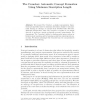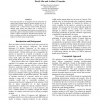286 search results - page 28 / 58 » Using inaccurate models in reinforcement learning |
SARA
2005
Springer
14 years 1 months ago
2005
Springer
Abstract. We present The Cruncher, a simple representation framework and algorithm based on minimum description length for automatically forming an ontology of concepts from attrib...
FLAIRS
2006
13 years 9 months ago
2006
This paper describes an investigation into the refinement of context-based human behavior models through the use of experiential learning. Specifically, a tactical agent was endow...
ICML
2010
IEEE
13 years 5 months ago
2010
IEEE
Temporal difference (TD) algorithms are attractive for reinforcement learning due to their ease-of-implementation and use of "bootstrapped" return estimates to make effi...
HT
2009
ACM
14 years 2 months ago
2009
ACM
Conversational recommender systems (CRSs) assist online users in their information-seeking and decision making tasks by supporting an interactive process. Although these processes...
ATAL
2008
Springer
13 years 9 months ago
2008
Springer
In reinforcement learning, least-squares temporal difference methods (e.g., LSTD and LSPI) are effective, data-efficient techniques for policy evaluation and control with linear v...


